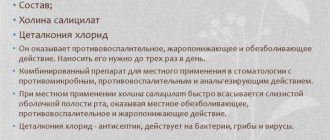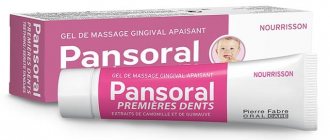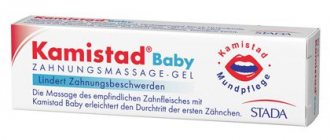Kalgel
Kalgel (lidocaine + cetylpyridinium chloride) is a drug for local anesthesia in dentistry. To realize its anesthetic effect, it is applied to the oral mucosa. Lidocaine is a local anesthetic. It is quickly absorbed from the site of application and enters the blood, where it interacts with plasma proteins. Rapidly undergoes metabolic transformations in the liver. Excreted along with urine. Cetylpyridinium chloride is a disinfectant. It is absorbed to a small extent in the oral mucosa. Kalgel is used to quickly eliminate pain during teething and prevent irritation (hyperemia, swelling) of the gums. It is used in pediatric practice after the child reaches three months of age. A single dose is about 7.5 mm of gel. Application and subsequent rubbing of the drug into the inflamed gums is done with the tip of your finger (before squeezing the required amount of gel onto your finger, you must wash your hands thoroughly). Repeated application is possible after 20 minutes, and the frequency of use of Kalgel should not exceed 6 times a day. If you strictly follow the instructions, the risk of developing any unwanted side reactions is minimal. In rare cases, after local injections, episodes of hypersensitivity to one of the active components of the drug, lidocaine, were recorded.
Manifestations of hypersensitivity - skin rashes, local swelling, slight difficulty breathing. Kalgel's herbal flavor contains chamomile, which can cause allergies in people predisposed to atopy. Cases of allergic reactions due to the consumption of herbal teas, which included chamomile, have been documented. If adverse reactions develop, you should stop using the drug and seek medical advice. Kalgel contains fructose, so the drug is contraindicated in persons with genetically determined fructose intolerance. The drug is contraindicated during pregnancy and breastfeeding (its effect in this category of patients has not been studied). If the recommended doses or frequency of use of Kalgel is exceeded, a decrease in the sensitivity of taste and temperature receptors located in the pharynx and oral cavity may develop. A similar case was described in a man who, while gargling, accidentally swallowed approximately 100 mg of lidocaine, which is equivalent to 5.5 g of Calgel gel. It should be noted that even if the recommended doses are significantly exceeded, the likelihood that toxic concentrations of lidocaine or cetylpyridinium chloride will be achieved is extremely low. The pharmacological interaction of Kalgel with other drugs has not been studied.
Kalgel 10g gel for children
pharmachologic effect
Local anesthetic.
Composition and release form Kalgel 10g gel for children
Gel – 1 g:
- Active ingredients: Lidocaine hydrochloride - 3.3 mg; Cetylpyridinium chloride - 1.0 mg;
- Excipients: Sorbitol solution 70% non-crystallizing - 210.0 mg; Xylitol - 140.0 mg; Ethanol 96% - 93.6 mg; Glycerol - 70.0 mg; Hyetellose - 25.0 mg; Macrogol glyceryl hydroxystearate - 10.0 mg; Lauromacrogol 600 - 3.3 mg; Macrogol-300 - 3.3 mg; Sodium saccharinate - 1.0 mg; Levomenthol - 0.6 mg; Herbal flavoring 17.42.5490 - 4.8 mg; Caramel E150 - 1.0 mg; Sodium citrate - 8.3 mg; Citric acid monohydrate - 1.05 mg; Water - up to 1000.0 mg.
Dental gel, 3.3 mg + 1.0 mg per 1 g.
10 g in an aluminum tube, varnished on the inside, with a screw-on plastic cap.
1 tube along with instructions for use in a cardboard box.
Description of the dosage form
A soft, homogeneous gel of yellowish-brown color with a characteristic odor, free from grains, lumps and foreign particles.
Directions for use and doses
For application to the mucous membrane.
Children
Kalgel® is intended for children aged 3 months and older.
A small amount of gel (about 7.5 mm) is applied to the tip of a clean finger and gently rubbed into the inflamed area of the child's gum. If necessary, the gel can be reapplied at intervals of 20 minutes, but no more than 6 times a day.
Patients with impaired renal function
Not studied.
Patients with liver dysfunction
Not studied.
Pharmacodynamics
Mechanism of action
The drug Kalgel® is an anesthetic used for application to the oral mucosa. In this case, lidocaine has a local anesthetic effect when applied to the mucous membrane. Cetylpyridinium chloride has antiseptic properties.
Pharmacokinetics
Suction
Lidocaine is quickly absorbed from the mucous membrane.
Cetylpyridinium chloride is poorly absorbed through the oral mucosa.
Distribution
Lidocaine binds to plasma proteins, including α1-acid glycoprotein (ACGP).
The degree of binding varies and is about 66%. The binding of lidocaine to plasma proteins depends on the concentrations of lidocaine and ACGP.
Any change in the concentration of ACGP can greatly affect the concentration of lidocaine in the blood plasma.
Metabolism
Lidocaine is largely metabolized in the liver. Metabolism in the liver occurs quickly. About 90% of ingested lidocaine undergoes dealkylation to form monoethylglycinexylidide and glycinexylidide.
Removal
Metabolites of lidocaine are excreted by the kidneys, with less than 10% excreted as unchanged lidocaine.
Indications for use Kalgel 10g gel for children
The drug Kalgel® is prescribed for teething.
Kalgel® helps to quickly relieve pain during teething and reduces the severity of gum irritation.
The drug Kalgel® also has a weak antiseptic effect.
Contraindications
- hypersensitivity to lidocaine, other amide anesthetics, cetylpyridinium or any other component of the drug;
- rare hereditary fructose intolerance;
- children up to 3 months of age.
Application of Kalgel 10g gel for children during pregnancy and breastfeeding
Fertility
Not applicable.
Pregnancy
Not applicable.
Breastfeeding period
Not applicable.
special instructions
Do not exceed recommended doses.
Impact on the ability to drive vehicles and operate machinery
Not applicable.
Overdose
Symptoms
As a result of excessive use of the drug Kalgel®, a decrease in pharyngeal sensitivity may be observed with a concomitant effect on swallowing. This effect was recorded in an adult who, while gargling, swallowed 5 ml of a 2% solution of lidocaine hydrochloride (equivalent to 100 mg of lidocaine). If we relate the body surface area to the pharyngeal surface area of a child aged 3 months, this dose will be equivalent to 5.4 g of Calgel®.
Even with improper or excessive use of the drug Calgel®, it is unlikely that large quantities of lidocaine hydrochloride or cetylpyridinium chloride will be achieved that could cause clinically significant toxic effects.
Treatment
In case of overdose, you must stop using Kalgel® and consult a doctor.
Side effects of Kalgel 10g gel for children
When using the drug Kalgel® in accordance with these instructions for use, adverse reactions are unlikely. However, isolated cases of hypersensitivity to lidocaine following local injections have been reported in adults and children over 12 years of age.
The hypersensitivity that occurred in these cases was expressed as localized swelling accompanied by minor difficulty breathing or a generalized rash.
Minor amounts of chamomile in herbal flavoring may cause allergic reactions, which has been documented. Hypersensitivity to substances contained in chamomile manifests itself in the form of difficulty breathing in individuals predisposed to atopy.
Anaphylactic reactions have been reported when taking herbal tea containing chamomile. Individuals with hypersensitivity may experience a positive skin reaction when using preparations containing chamomile.
If any undesirable reactions occur, you should stop using Kalgel® and consult a doctor for advice.
Drug interactions
There is no data on the interaction of Kalgel® with other drugs.
There is evidence of the interaction of lidocaine (when administered intravenously) with the following drugs when taken orally: procainamide, phenytoin as monotherapy or in combination with phenobarbital, primidone or carbamazepine, propranolol and potassium-sparing diuretics, including bumetanide, furosemide, and thiazide.
KALGEL (gel)
The place became significantly less dramatic and hectic.
At first I was skeptical about the advice - for the sake of sport, I tried Kamistad and Kholisal ointments - almost like a poultice for a dead person. It’s strange, since the first one contains the same lidocaine, it seems. And the primary purpose of Kalgel is teething of children’s teeth, I thought that there would obviously be nothing to surprise me with. I thought wrong. Unlike Kamistad, using Kalgel is not so disgusting - the cooling effect (caused by ruminant sorbitol and levomenthol, as I understand it) is much more appropriate here than the incomprehensible heating of the cavity when using the former. I have nothing against chamomile, but in Kamistad it is disgusting, although the remedy itself is, on the whole, not bad.
Kalgel tastes something refreshing and sweet. It looks like a caramelized mixture. By the way, they are not far from reality - the composition contains the additive caramel e150. There are no foreign inclusions, no grains - a homogeneous mass that does not cause irritation, at least for me.
The drug takes effect within a minute or two, the main storm subsides almost immediately, you can take care of your own life or sleep peacefully if the demons have overcome you at night. The problem is that it doesn’t last very long, so I use it several times a day, if Ketorol is not an option.
Used both for regular pain management and as care after dental surgery during the healing period. A very severe pain, of course, will be overcome by something worse, but still worthy. It even relieves swelling a little. By the way, this ointment works well with Nimesil, a non-steroidal anti-inflammatory agent in powder form. We dilute it and drink it, it’s not very nasty, it gives off a hint of citrus - we lubricate it with Kalgel.
The tube itself comes, as indicated, with foil protection; the cap has a recess with a sharp notch.
I overdosed more than once, nothing terrible happened - you won’t get those doses of lidocaine that can lead to frankly sad consequences, which can be achieved with the same lidocaine spray if you take it to your heart’s content. Nevertheless, accuracy has never failed anyone, and for a small child, I still think the dose should be maintained as indicated on the pack and in the instructions.
Allergy sufferers should be careful - there is a small amount of herbs here. In addition, the composition contains glycerol and macrogol-300, which have a slight laxative effect. This is not indicated in the side effects; probably, the substances practically do not manifest themselves.
In addition to lidocaine, the ointment contains the antiseptic cetylpyridinium chloride and lauromacrogol-600, an anesthetic little known to me, which is part of Hepatrombin, known in certain circles. Macrogol glyceryl hydroxystearate and hyaetellose in the composition play the role of a stabilizer and give the ointment a digestible, homogeneous appearance. Citric acid monohydrate - most likely as a preservative, given the couple of years of life of the drug after opening. Sweetener: xylitol.
Sheets instruction manual:
The volume is small, if the pain is severe, it is enough for an adult for a couple of sessions (more than once) of salvation, depending on the intensity of the disaster.
UPD: The other day I severely burned my finger, for some reason it was not lidocaine spray that helped, not Panthenol - they started to burn even more - but Kalgel. I tried it out of interest, and the swelling quickly subsided. Multi-pass.










